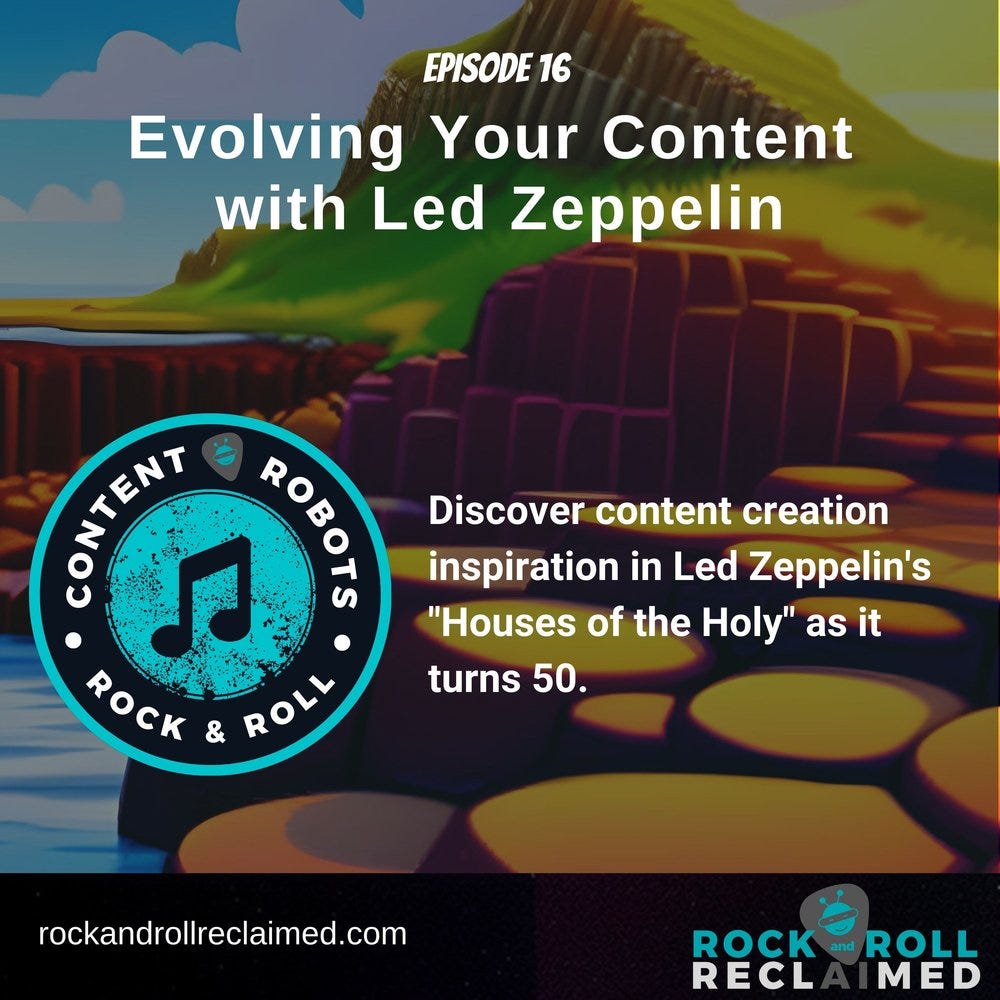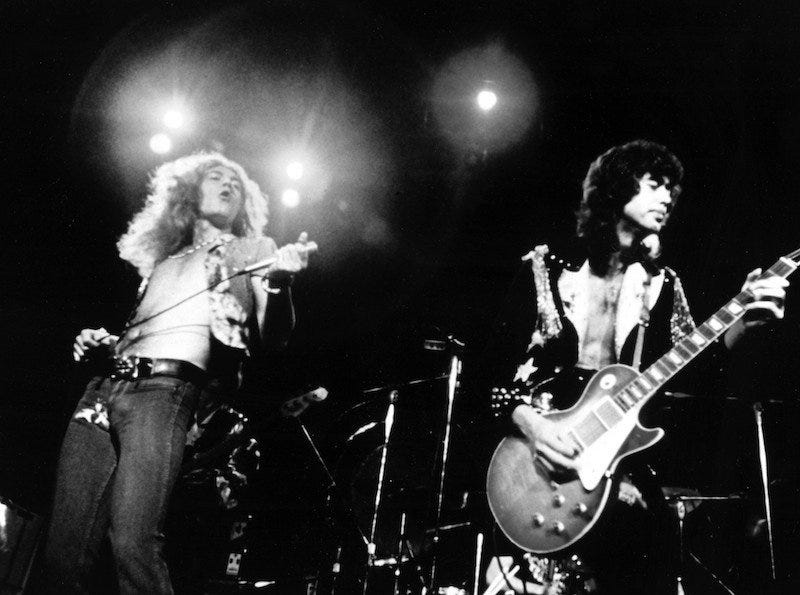Podcast Episode Details
A few weeks ago, we talked about Pink Floyd's "The Dark Side of the Moon" as it turned 50 years old. This week, we celebrate "Houses of the Holy," which was released on March 28, 1973. Listen to the podcast to learn about:
The significance of "Houses of the Holy" in Led Zeppelin's discography, and how it marked a departure from their earlier albums.
The diverse themes and production innovations on "Houses of the Holy," which gave the album a richer, more polished, and sophisticated sound.
The importance of maintaining a consistent brand voice and point of view while experimenting with new genres or mediums.
The lessons content creators and marketers can learn from "Houses of the Holy," such as taking risks, pushing boundaries, embracing outside inspiration, and building emotional connections with audiences.
An iconic departure: "Houses of the Holy"
What makes "Houses of the Holy" so special? Why was it considered such a departure from Zeppelin's previous releases? What lessons can we take from the album as creators and content marketers?
"We've done four already, and now we're steady:" considering Led Zeppelin's first four albums
Led Zeppelin III is probably my favorite Zeppelin album. There are so many great songs on that one: Gallows Pole, That's The Way, Out on the Tiles, Since I've Been Loving You — which, for a long while, I considered to be my favorite Led Zeppelin Track.
Led Zeppelin's first four records are iconic. You can draw a straight line from what guitarist Jimmy Page was doing with Jeff Beck in the Yardbirds to what started to happen with Led Zeppelin. Blues-inspired rock & roll with a heaviness and urgency that hadn't really been reached by other bands of the time.
Throughout those first four albums they also incorporated English folk and American bluegrass, as well as mythical and mystical themes that formed and "completed" the Led Zeppelin sound.
That culminated in "Led Zeppelin IV", or "Zoso", or simply "Led Zeppelin" depending on how you want to describe the untitled record. "IV" is seen by the masses to be the pinnacle of Led Zeppelin's power, with tracks like "Black Dog," "Rock and Roll," "When the Levee Breaks," and, of course, "Stairway to Heaven."
The art of experimentation: evolving musical styles
"Houses of the Holy" marked a significant departure from what we heard on those first four albums. The album has been compared to the evolution of the mid-1960s Beatles in some ways. Both bands built upon their music of the past, yet branched out into new, more expansive musical areas.
"Houses of the Holy" saw Led Zeppelin branching out into various musical styles, such as funk (in "The Crunge"), reggae (in "D'yer Mak'er"), and progressive rock (in "No Quarter"). This experimentation gave the album a more diverse and eclectic sound.
Diverse themes and production innovations
Led Zeppelin's earlier albums often dealt with themes such as love, sex, and mysticism. "Houses of the Holy" did as well, but it featured an even broader range of subjects. For instance, "The Song Remains the Same" explores the power of music, "The Rain Song" deals with love and longing, and "No Quarter" has a darker, more introspective tone.
The band was always experimental and innovative with their production styles. On "House of the Holy," they continued to experiment with studio techniques and effects like layering of guitar and other instruments, phasing, and echo. They also used synthesizers on this album — particularly on "No Quarter."
This experimentation resulted in a richer, more polished, and sophisticated sound.
Provocative album artwork
Unlike the band's first four albums, which featured minimal or ambiguous designs, "Houses of the Holy" really put itself out there from a visual imagery standpoint.
The band worked with London design house Hipgnosis to create something new, different, evocative, and provocative. Hipgnosis had also created the "pyramid and prism" album cover for 1973's "The Dark Side of the Moon" as well as much of Pink Floyd's early artwork. They went on to create art for many bands throughout the 1970s.
The "Houses of the Holy" album cover depicts a provocative image of naked, golden-haired children crawling and climbing up the rocks of Giant's Causeway in Northern Ireland.
It was, and remains, a controversial album cover designed to grab attention. The first four Zeppelin albums, from my point of view, were designed to let the music do all the work. They were pretty boring, particularly by comparison. With "Houses of the Holy," the cover artwork did some of the work of leading listeners into the band's evolved and artistic sound and style.
Pushing the boundaries
Perhaps these changes were a result of the band getting bored with the heavy blues-based rock music that they were known for. Perhaps it was their desire to push new boundaries and take risks. I suspect it was a combination of both. "Houses of the Holy" stands as a testament to the band's artistic growth and their ability to push the boundaries of their sound while still maintaining their unique identity.
No matter how far they pushed, Plant's soulful vocals were still mesmerizing. Page's guitar work was soulful, bluesy, and a little sloppy, but I mean that in the best way. John Bonham's driving, booming, heavy percussion was as important to the band's sound as Page and Plant's.
John Paul Jones is the guy that people seem to forget about. His inventive bass lines were iconic and integral to the sound of Led Zeppelin. He built a pocket and a groove with Bonham that set the foundation for the Zeppelin sound.
Those things — the fundamentals of the Zeppelin sound — didn't change, even when their music evolved. With the benefit of 50 years of hindsight, we now see "The Rain Song", "No Quarter", and "The Ocean" in the same light as we see "Good Times Bad Times", "Stairway to Heaven", and "Whole Lotta Love."
Creativity in Content Marketing: Lessons from "Houses of the Holy"
But this is a post about digital content creation. What does "Houses of the Holy" have to do with content marketing?
"Houses of the Holy" showcases the band's musical evolution, incorporating a variety of styles such as funk, reggae, and progressive rock. but it still kept their signature hard rock and blues sound for all the reasons I just talked about.
As storytellers, we can take risks. We can push the envelope. We can try new things, as long as they're rooted in our fundamentals:
Our brand
Our point of view
Our expertise
Our story
Led Zeppelin stretched boundaries and took risks within the boundaries of their signature sound.
A new, but familiar, journey
Take your audience on a new, but familiar journey. Opening them up to new ideas is most successful when rooted in something that's familiar, useful, or comfortable.
Experimenting with new genres or in new mediums within the content we create can lead to audience growth and development. That's great, but don't forget that maintaining your consistent brand voice, style, and point of view is essential for building trust and recognition with your audience.
Your audience, no matter what size it is, follows you for a reason (see the fundamentals listed above for some of those reasons). Finding creativity and nuance within those parameters can allow you to create something truly special.
Embracing influence and inspiration
Led Zeppelin didn't create "Houses of the Holy" in a vacuum. New and interesting music from Zeppelin's peers was coming out in the early 1970s that influenced the band's sound. Pink Floyd is an example. The progressive music of Genesis, Yes, and King Crimson iss another. Reggae music and Bob Marley also had a profound impact.
Influence and inspiration is important. Now, Led Zeppelin often took the concept of "inspiration" a bit too literally, as we'll discuss in future content. In general, inspiration and influence is important as it helps us to find better ways of communicating with and growing our existing audience.
Inspiration helps us avoid stagnancy. In some cases, it helps us to get started and serves as a foundation for finding our own voice and point of view. Don't be afraid to get inspired by others.
Emotional connection: the key to storytelling
There's an emotional connection found in the music on "Houses of the Holy" that's somewhat different from what we hear on the earlier Zeppelin albums. Many of the songs on the album evoke strong emotions, such as the longing in "The Rain Song" or the uplifting spirit of "Dancing Days." "Houses of the Holy" takes us on a journey that's different than the others up to that point.
Emotion is vital to great storytelling and audience experience. Building an emotional connection with the audience is a crucial aspect of content marketing. If done well, it can foster deeper engagement, brand loyalty, and advocacy.
Celebrating "Houses of the Holy" at 50
Great content happens by embracing change, creativity, inspiration, and emotional connection. Content must always remain rooted in our core fundamentals of brand, expertise, point of view, and story.
Content creators can use the "Houses of the Holy" blueprint to create engaging and memorable content that breaks ground, stretches boundaries, and resonates with audiences in new and exciting ways.
Listen up!
Below you can access "Houses of the Holy" on Spotify and Apple Music. Celebrate the album's 50th anniversary and give it a listen if you haven't heard it. If you have heard it, give it a listen with fresh ears today. My favorite tracks on the album are "The Song Remains the Same," "The Rain Song," and "No Quarter." I'd love to hear yours too.









Evolving Your Content with Led Zeppelin